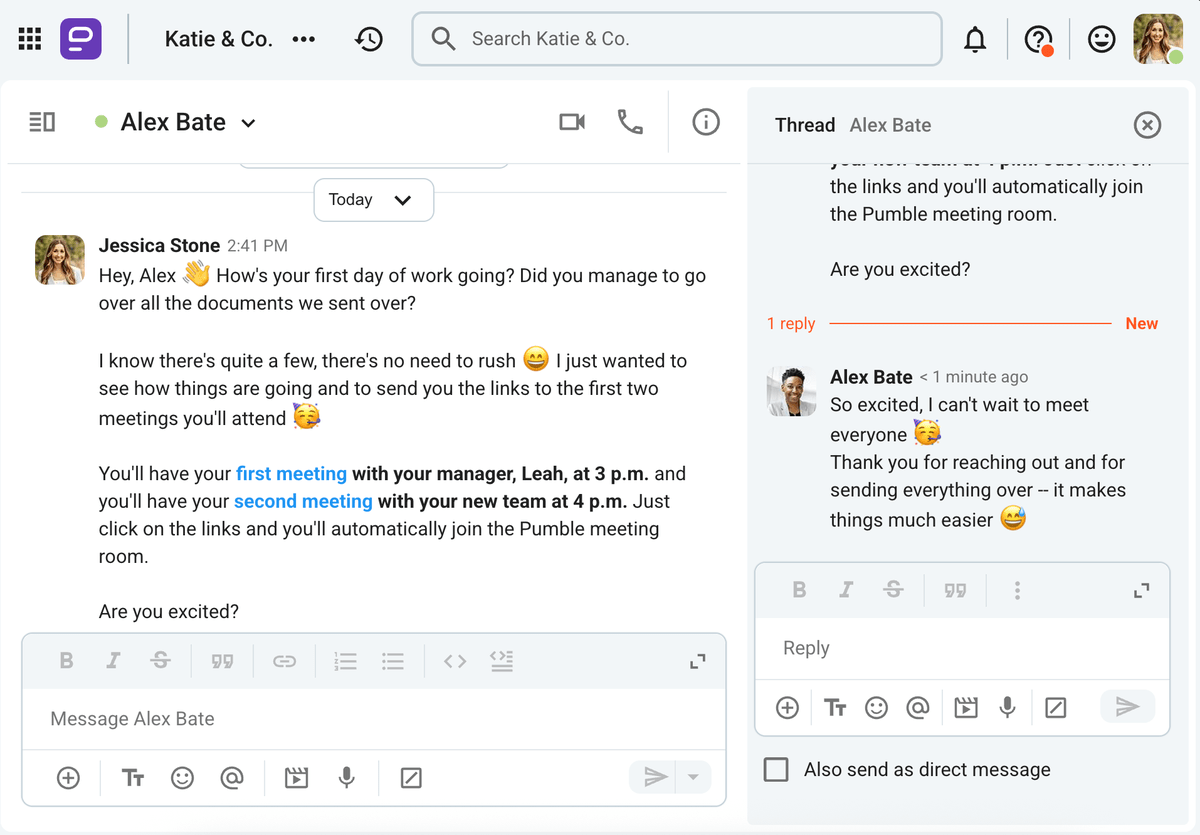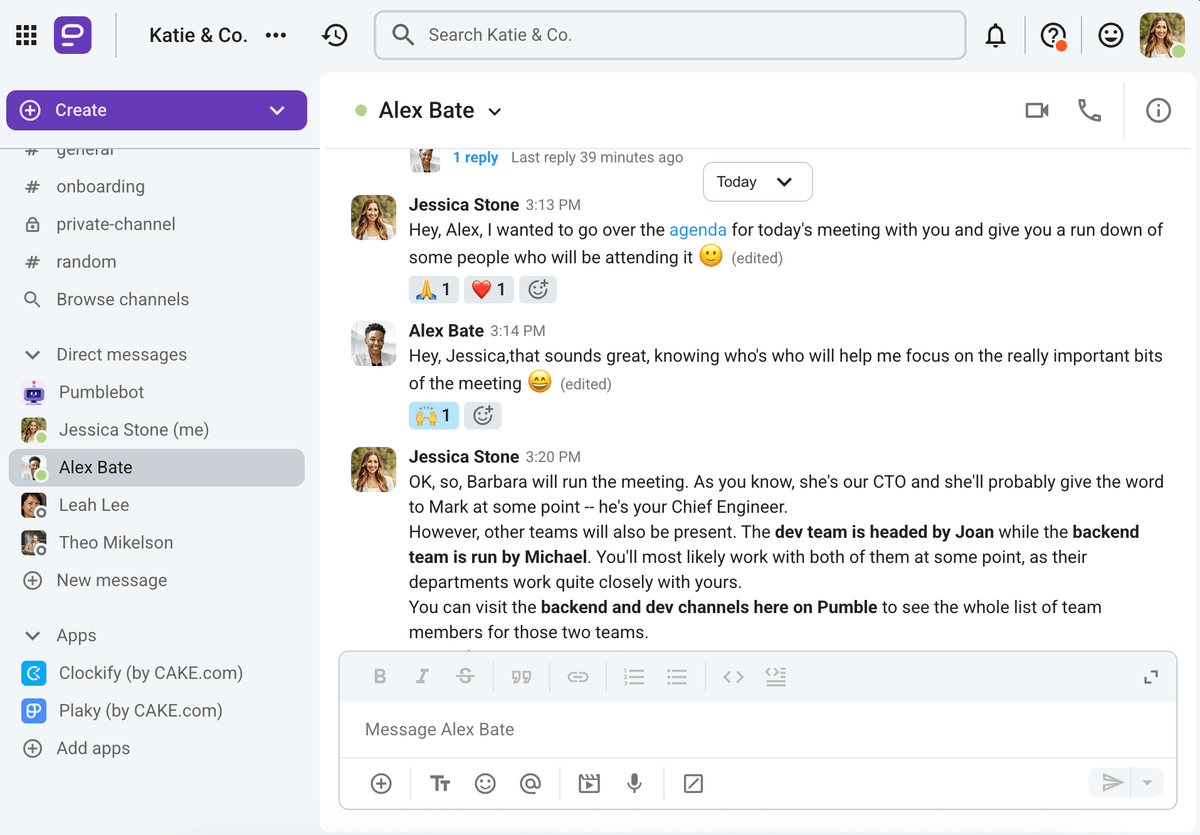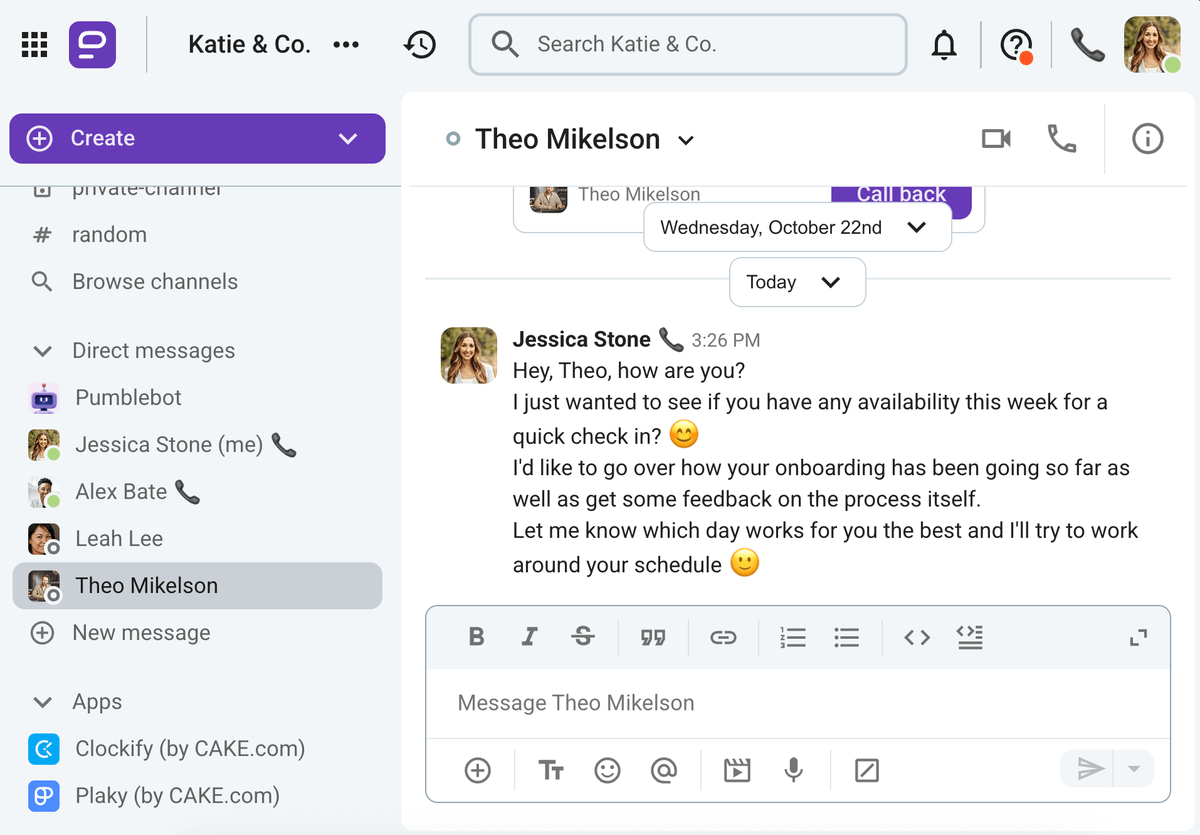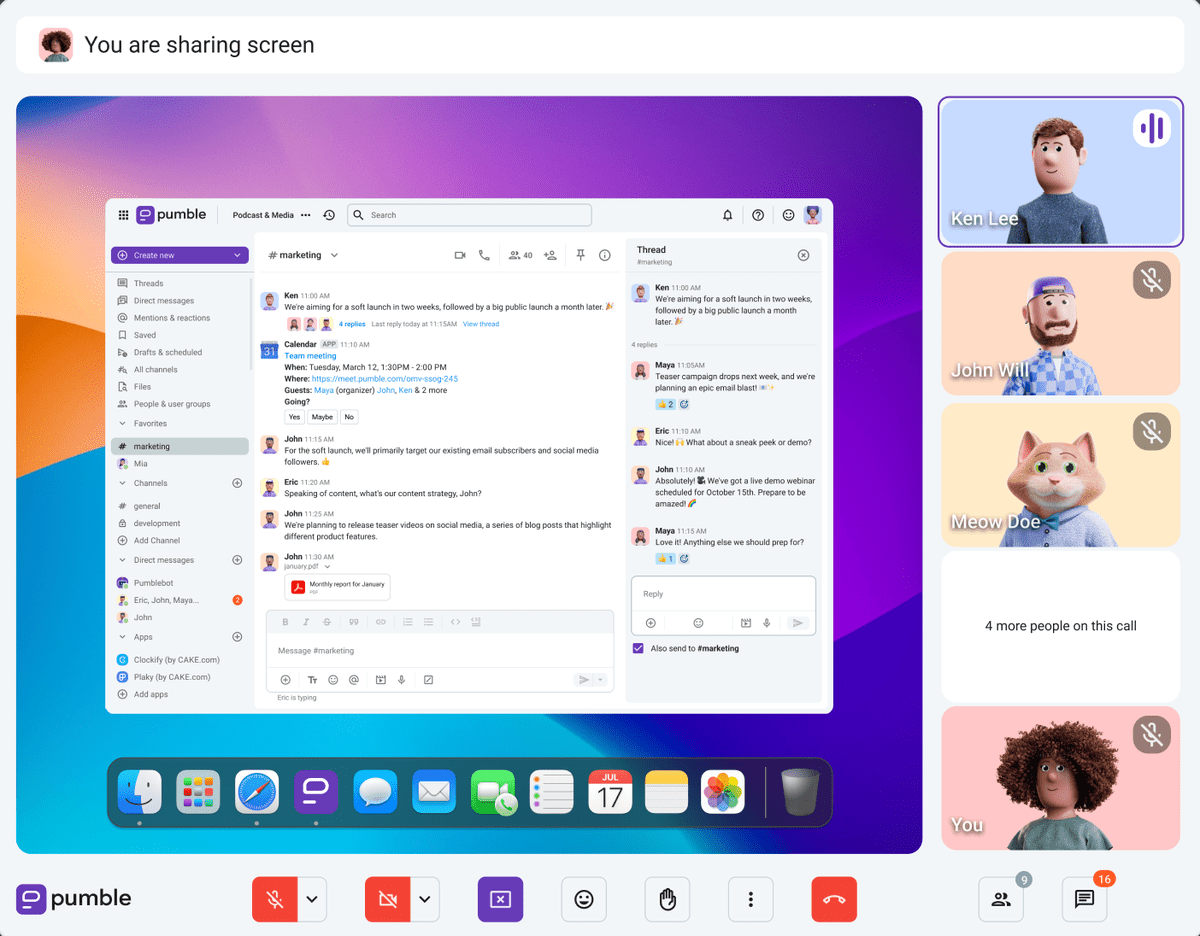Finding the perfect candidate for your team is only half the job, believe it or not. Properly onboarding them — without crushing their enthusiasm — is the other, bigger half.
And, yet, 88% of companies fail to accomplish this. Getting new hires acclimated to their new professional environment is vital for their (and your) success, but doing so is no easy feat — clearly.
That’s why we prepared this comprehensive employee onboarding guide that covers:
- What onboarding is,
- Why proper onboarding is vital for businesses,
- What the 4 phases of onboarding are, and
- How you can ensure your onboarding process is top-notch.
We’ll also provide a free onboarding template you can use and customize to your needs.
Let’s dive in!

- Employee onboarding is the process of integrating new hires into the company culture and familiarizing them with their roles and responsibilities.
- A well-designed onboarding program can improve employee engagement by 4.3 times and increase new hire productivity by up to 70%.
- The 4 phases of onboarding are:
- The pre-onboarding phase, which lasts from the moment a candidate accepts your offer to their first day of employment.
- The welcoming phase, which lasts for one or a couple of weeks.
- The training phase, which lasts for the first 90 days of employment.
- The transitioning phase, which lasts for anywhere between 3 months to a year.
Table of Contents
What is employee onboarding?
Employee onboarding is the process of integrating new hires into the company culture and familiarizing them with their roles and responsibilities.
The onboarding process includes, among other things:
- Supplying new employees with company-issued equipment,
- Introducing new hires to their teams,
- Providing ongoing education, and
- Tracking the effectiveness of the program.
The onboarding process is the employer’s way of fulfilling promises made during the recruitment stage. It also sets the stage for the employee experience — it shows what the employee can expect in the following months and years.
Yet, as mentioned, around 88% of companies fail to properly onboard their employees, according to Gallup’s report. In fact, only:
- 29% of new hires would say that they feel fully prepared and supported in their new roles, and
- 12% of employees can confidently claim that their company does a great job of onboarding new staff.
According to Lisa M. Sanchez, a Vice President of Employee Experience and Engagement, integrating new hires well is a crucial part of the recruitment process:

“Employee onboarding is one of the most important first steps when introducing new hires to the organization. After investing so much in the recruitment process, employers should invest just as much time and effort in onboarding so that new hires are informed, prepared, and ready to work.”
But, why should organizations put that extra effort and resources towards onboarding new employees?
The data-backed case for onboarding: Why onboarding is more important than you think
According to a report from Bamboo HR, as many as 70% of newly hired employees decide whether a job is a good fit for them within the first month of getting hired — with 29% of them knowing within the first week.
A well-designed onboarding program leaves a good first impression as well as:
- Expedites the integration of new hires into the company culture and helps them understand what is expected of them. This significantly reduces the stress that naturally accompanies any change.
- Improves employee engagement by 4.3 times. Gallup’s research shows that employees who feel connected to the company culture are 4.3 times more likely to be engaged in their work and 62% less likely to burn out.
- Increases new hire productivity by up to 70%. Employees that were properly trained during onboarding can contribute faster and perform tasks more efficiently — another Gallup study suggests that proper onboarding can increase productivity by up to 50–70%.
- Increases employee retention by 82%, according to Gallup. Another research paper suggests a more moderate number — 64.2%. Either way, onboarding and retention are closely connected.
- Prevents the company from wasting money on training more employees due to employee turnover. The average cost of a bad or a badly onboarded hire is $17,000 — and that number is much higher for senior and executive roles.
All of this is something the HR specialists are well aware of — as reported by Katarina Mihaljev, an Employee Experience Specialist who’s been placed in charge of onboarding new hires at CAKE.com:

“Well-conducted onboarding increases the chances that employees will stay in the company for a longer period, because it creates a sense of belonging and trust from the start.
In addition, it makes it easier for them to master tools and procedures, thus increasing their productivity. For the company, this means consistency in standards and greater efficiency in work.”

Centralize your onboarding resources
What does the process of onboarding look like? The 4 phases of onboarding
When it comes to onboarding best practices, different HR professionals would provide various answers to the question of what they are. After all, not everyone uses the same employee onboarding framework to train their new hires, nor should they — as Lisa M. Sanchez pointed out:

“There is not a one-size-fits-all approach to new hire onboarding. Engaging in a variety of methods, whether the 4 phases or the 5 C’s, is necessary for an effective transition.”
But, as far as employee onboarding frameworks go, the 4 phases of onboarding are somewhat of a fan favorite model among HR professionals. As the name suggests, this framework consists of 4 phases:
- Pre-onboarding,
- Welcoming,
- Training, and
- Transition.
Let’s take a deeper look at each of them.
Phase #1: Pre-onboarding
The first phase of onboarding starts as soon as the candidate accepts your offer and lasts until their start date.
This is a vital step — one you shouldn’t skip.
After accepting the offer, the candidate will most likely be completely uncertain about what lies ahead of them. So, any miscommunication or misunderstanding can make them doubt your organization and their decision to join it.
According to Katarina Mihaljev, properly preparing the candidate and explaining what’s to come can ensure the success of this first phase:

“It all starts with preparation. When a new employee receives basic information in advance about the company, their team, and the first day of work, they enter the process much more easily.”
During the pre-onboarding phase, you should send the necessary documents and paperwork to the candidate. Give them enough time to actually complete it and make sure they know they can turn to you for help at any time during this process.
It’s also a good idea to send them a document (or even a video) that will give them some idea about what they can expect during their first days and weeks in the company.
💡 Pumble Pro Tip
Miscommunication can cause a lot of trouble even after the pre-onboarding phase. To learn how to recognize and handle it, read our post:
Pre-onboarding phase: Checklist
To ensure you don’t skip any steps, here’s a pre-onboarding checklist you can follow:
- Send the candidate a welcome email that has the essential information about the company, team, and what they can expect during their first day.
- Include the necessary paperwork in the welcome email (or send it as a separate email), and offer the candidate any help they might need with it.
- Provide access to the communication and collaboration tools they will use, such as email, project management software, team communication app, etc.
- Share an agenda for the first week that outlines the meetings, training sessions, and other crucial moments that will happen during the first week.
- Familiarize the candidate with the company’s amenities, benefits, and development plans.
Keeping the candidate informed and the lines of communication open will ensure they maintain their enthusiasm for their new role.
Phase #2: Welcoming
The second phase of onboarding is the welcoming phase, and it usually lasts for one or a couple of weeks.
It’s dedicated to welcoming new employees into the organization and providing guidance and orientation to help them acclimate to the new surroundings, team, and company as a whole.
The new employee most likely doesn’t know anyone in the company, nor do they know how teams and the company operate. It’s vital that you:
- Give them a clear picture of your company culture during this phase and
- Show them how that culture is reflected in your practices.
One of our experts, Mary Schroeder, a Chief HR Officer with over 20 years of experience, uses this phase to ensure employees understand what their first few weeks will look like, in addition to explaining what they can expect from the company in terms of PTO, payroll schedule, and benefits. Then, she goes over their training schedule:

“[During the welcoming phase], I supply the new hire with the 3-week training program we have in place for all new hires, so they have an opportunity to see what their first few weeks will look like before their first day.”
Remember, almost ⅓ of new employees know whether a company is a good fit for them within this first week — so use this time wisely. Our resident expert, Katarina Mihaljev, highlighted the importance of this phase:

“First impressions are key. Small gestures of attention, such as an organized welcome or a gift package, can go a long way in making an employee feel accepted right away.”
At the same time, you should keep in mind that you shouldn’t overwhelm the new employee. Keep the first day as simple as possible, while also giving them all the necessary information.

Hold team meetings over Pumble
Welcoming phase: Checklist
To ensure you make the most out of those first few weeks without overwhelming your new employee, follow this welcoming phase checklist:
- Hold a first meeting with the employee during their first day to introduce them to the organization culture and discuss topics like time off, payroll schedule, attendance, insurance, etc.
- Give the new employee a welcome kit that includes some branded items to show you value and appreciate them.
- Hold a team lunch or a virtual meeting to introduce the new employee to teammates, colleagues, and other relevant stakeholders.
- Give an in-person or virtual tour of the office to the employee, and explain where they can find key information and resources and who they can turn to for help or assistance.
- If you haven’t done so during the pre-onboarding phase, provide the employee with access to all the necessary tools.
Phase #3: Training
According to Gallup, new employees don’t reach their peak potential until they’ve been with the company for a year. The training stage of onboarding helps employees reach their full potential.
Without the proper training, employees don’t know what’s expected of them, which may lead to dissatisfaction and disengagement. According to Pumble’s Workplace Communication Statistics, ineffective communication of expectations causes disengagement in 35% of employees.
Conducting effective training during onboarding is your chance to lower that number right from the get-go by providing knowledge and instilling confidence, as noted by Katarina Mihaljev:

“[During training] employees are provided with concrete knowledge about their tasks, tools, and ways of working, which allows them to be more confident in their contribution.”
To ensure that the new employee is getting all the information and training they need, you can introduce a mentor, as advised by Mary Schroeder:

“Once training starts, the process of transitioning the new hire into their role begins. We assign a mentor to the new hire to help transition them into the position. This helps them feel like part of the team.”
This phase is also the ideal opportunity to introduce new hires to cross-functional teams they might end up working with. This will give them a clear picture of how different departments collaborate and how the entire company is organized.

💡 PUMBLE PRO TIP
Interested to know more about employee engagement, what affects it, and how you can improve it? Then check out our guide:
Training phase: Checklist
To ensure the training phase goes smoothly, follow this checklist:
- If you have a learning system or a knowledge base, help the employee familiarize themselves with it.
- Break down this phase into manageable modules that cover knowledge areas and skills necessary for the role.
- Include hands-on training sessions into your training program to ensure the employee can apply what they’ve learned.
- Introduce training sessions with a mentor who will help the employee gain more thorough practical knowledge.
- Schedule regular check-ins with the employee and their manager to track their progress to see where the employee might need additional support.
- Ensure the employee has continuous access to the company’s learning materials and knowledge base. Using an internal communication software with unlimited message history can be helpful, as it allows you to provide full access to all materials to new hires.
Create your knowledge base on Pumble
Phase #4: Transitioning
Completing the training of the new employee shouldn’t mark the end of the onboarding process. The final phase of onboarding is transitioning the employee from a “new hire” into a fully operational, independent worker.
Offering employees support during this phase is just as important as the rest of the process, as testified by Katarina Mihaljev:

“After training, it is important that employees have support as they gradually become independent. Regular feedback and mentoring help them navigate the first challenges more easily.”
During this stage, it’s a good idea to set some goals for the employee and have regular check-ins to keep them informed about their progress.
However, don’t forget that constructive feedback, like any other communication, should go both ways — so leave some time and space for the new employee to provide their own feedback to the entire process.
You’ll find that requesting feedback from new employees doesn’t have to be a formal affair at all — just send them a quick direct message, as shown in the image below.

Transitioning phase: Checklist
Although it’s the final phase of onboarding, transitioning is not to be overlooked. To help you make your way through it with ease, here’s a quick transitioning phase checklist:
- Encourage continuous learning and development of various skills by offering different resources — learning materials, workshops, training sessions, etc.
- Schedule regular check-ins where you’ll be able to provide support, share concerns, as well as give and receive progress feedback.
- If you haven’t done so in the previous phase, assign a mentor who will provide guidance to the employee regarding their tasks, responsibilities, and overall role.
- Alternatively, you can include them in the buddy system by pairing them with a work buddy — someone who is an already established worker in the organization who can show the new employee the ins and outs of the company.
- Encourage the new employee to provide feedback regarding their onboarding experience. This feedback can help you pinpoint areas of improvement that will allow you to make the necessary changes to the entire process.
- Provide recognition for all milestones and accomplishments of the new employee. You can do that by praising them in a public channel on your team communication app or during a team meeting.
Celebrate achievements on Pumble
The 30-60-90 onboarding plan for new employees
While your new employee goes through the 4 stages of onboarding, you can follow their progress (and outline their milestones) with the 30-60-90-day plan.
This onboarding plan helps the employee navigate the first 90 days of their employment and ensures they have clarity when it comes to goals and responsibilities.
Essentially, a well-constructed 30-60-90-day plan covers everything that should happen during the second, third, and fourth phase of onboarding.
At the 30-day mark, new employees should understand:
- Their responsibilities,
- Company’s internal policies,
- The organizational structure, and
- Business model.
By the 60-day mark, employees should be able to put what they’ve learned during the onboarding process into practice.
During this time, most new hires will still make some mistakes. That is to be expected — as long as they are willing to correct their blunders upon receiving feedback.
Lastly, by the 90-day mark, employees should have fully mastered the tools and skills they need to do their jobs.
We’ve created a customizable 30-60-90-day plan with action items that you can download and tailor to your needs for every new hire. Check it out below.

Download our 30-60-90-day plan
Download our printer-friendly 30-60-90-day plan
Implementing an onboarding process that lasts for 3 months is an excellent practice — and prolonging it even further isn’t a bad idea either. According to Lisa M. Sanchez, you can extend the onboarding practices to up to 6 months:

“We have implemented a 30- and 60-day entry interview process whereby new hires voluntarily complete a questionnaire about their:
- Hiring experiences,
- On-the-job training,
- Workplace experiences, and
- Whether they have the tools and resources needed to perform their job or need additional training.
In addition, we have 90- and 180-day introductory performance evaluations to create early communication between new hires and their supervisors to ensure that the employee is successful. In total, our onboarding spans 6 months.”
Hold meetings, make calls, stay connected
Pumble: Your digital hub for seamless onboarding
Ultimately, your employee onboarding process will be tailored to your company’s needs.
Following the 4 phases of onboarding won’t look the same in every company, and the details of each phase might even differ from role to role. The same goes for the accompanying 30-60-90-day plan or any type of new hire onboarding checklist you make.
But, no matter what your onboarding process looks like, partnering with a powerful and secure team communication app is sure to enhance your employee onboarding process.
An app like Pumble can support the entire onboarding experience through all 4 phases:
- Pre-onboarding — Thanks to Pumble’s private channels, you can create a space for the new hire, their manager, their mentor or work buddy, and the HR representative before the actual start date. That way, everyone involved in the onboarding process can get to know each other and build rapport. This can also be the space where you share important details and paperwork with the new hire.
- Welcoming — Pumble’s public, company-wide channels are the ideal space for you to publicly welcome the new hire and introduce them to their team and important stakeholders. These channels can act as your knowledge base, so this is also where the new hire will be able to find all relevant resources that will help them out during their first week on the new job.
- Training & Transitioning — Hold voice and video sessions to train the new hire, and slowly introduce them to your company’s processes and procedures as well as other teams. Schedule regular check-in meetings via Pumble and advise them to include the Google Calendar add-on to their workspace to ensure they don’t miss any important meetings during their hectic first month.

Pumble is an excellent solution for companies of all sizes, as it doesn’t place any limits on the number of users you can have in your workspace.
It also offers unlimited message history for all users, which means you can store all your onboarding materials, guides, and resources on it, and they will be available to all new hires — forever.
The paid version of the app will even grow with your company, adding more storage space to your workspace with every new employee that comes onboard.
Elevate your employee onboarding program — try Pumble today.






